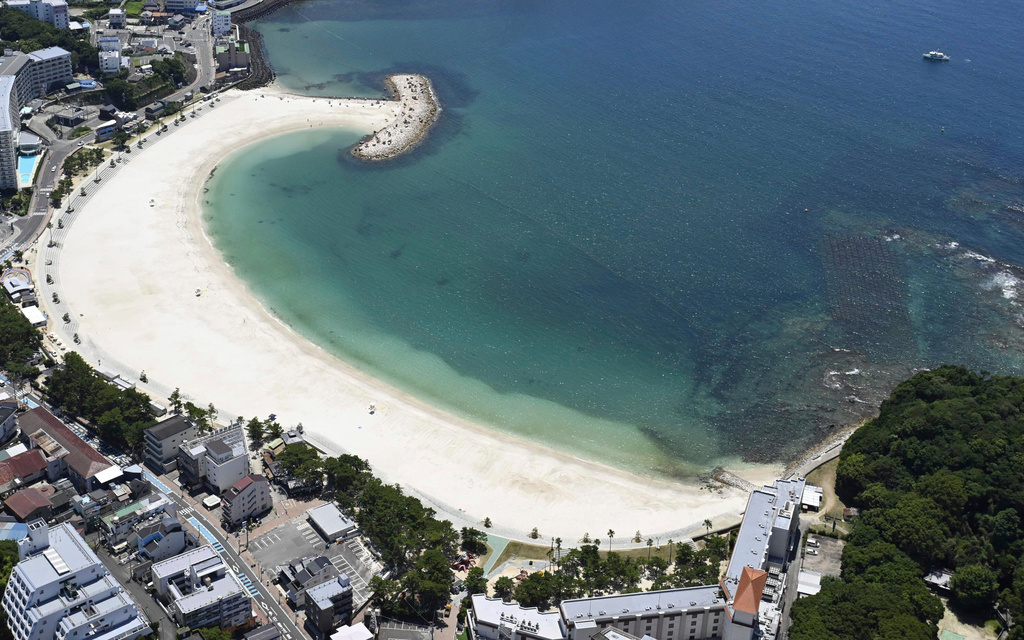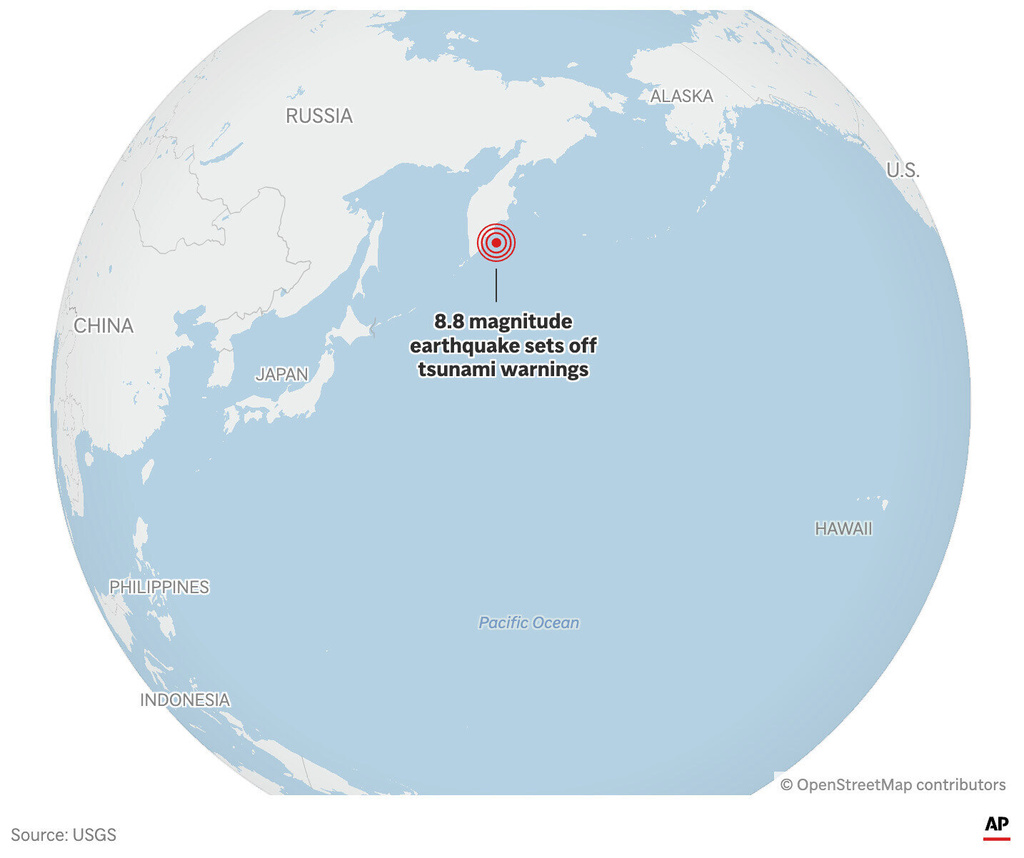Tsunami Alerts Issued After Kamchatka Earthquake \ Newslooks \ Washington DC \ Mary Sidiqi \ Evening Edition \ A magnitude 8.8 earthquake struck Russia’s Kamchatka Peninsula, triggering tsunami alerts across the Pacific, from Japan to New Zealand. Waves were observed in Alaska and Japan, but no major damage or injuries have been reported. U.S., Canadian, and Asian officials urged coastal evacuations amid fears of additional surges.

Quick Looks
- 8.8-magnitude quake struck near Kamchatka, Russia early Wednesday.
- Tsunami waves recorded in Japan, Alaska, Hawaii, and expected across the Pacific.
- Pacific Tsunami Warning Center urged urgent evacuation in Hawaii.
- Small waves reported in Oregon, British Columbia, and Mexico.
- Japan evacuated over 900,000 people from 133 municipalities.
- Russian coastal towns reported damage but no serious injuries.
- The quake is the strongest since Japan’s 2011 disaster.
- Philippine, New Zealand authorities issued shoreline evacuation warnings.
- Sendai Airport closed briefly; ferry and train service in Japan disrupted.
- Experts warn aftershocks may continue for a month.
Deep Look
Russia’s Massive 8.8 Quake Triggers Widespread Tsunami Alerts Across Pacific Region
One of the most powerful earthquakes recorded in over a decade struck Russia’s Far East early Wednesday, shaking coastal cities and triggering tsunami alerts from Japan and Alaska to Hawaii, Mexico, and as far south as New Zealand. The magnitude 8.8 quake struck near the Kamchatka Peninsula, just 74 miles (119 kilometers) from Petropavlovsk-Kamchatsky, a city of 180,000.
While no deaths or serious injuries have yet been reported, the event has caused global alarm and significant disruption to coastal regions across the Pacific Rim.
Pacific-Wide Tsunami Alerts and Global Impact
Within minutes of the earthquake, the Pacific Tsunami Warning Center (PTWC) in Honolulu issued alerts for all Hawaiian islands, urging residents to seek higher ground immediately. Waves were forecast to arrive by 7 p.m. Tuesday local time, and sirens blared across Honolulu as roads clogged with residents fleeing the coastline. Hawaii schools canceled all after-school and evening activities.
Oregon, British Columbia, California, and parts of Mexico also came under tsunami advisories. In Alaska, the National Tsunami Warning Center reported wave heights of under 1 foot (30 cm) in Amchitka and Adak, though residents were told to remain cautious due to the ongoing series of waves.
In Japan, the Japan Meteorological Agency recorded a tsunami of 50 cm (1.6 feet) at Ishinomaki port, with other minor wave observations reported in northern coastal regions. In response, Japan issued evacuation advisories to over 900,000 residents across 133 municipalities, spanning from Hokkaido to Okinawa.
Local transport was disrupted, with ferries suspended between Hokkaido and Aomori, and Tokyo’s island ferries halted. Sendai Airport briefly closed its runways. Despite the panic, Japan’s Fire and Disaster Management Agency said no injuries or damages were reported.
Russia Reports Local Damage, Evacuations
The earthquake caused power outages, mobile phone service interruptions, and building damage in Petropavlovsk-Kamchatsky. According to the Health Ministry, several people sought medical assistance, but no serious injuries were reported.
The first tsunami waves hit Severo-Kurilsk, a town on the Kuril Islands, where residents were evacuated to high ground. Governor Valery Limarenko confirmed no casualties and said the population remained sheltered until further waves passed.
The Geophysical Survey of the Russian Academy of Sciences described this as Kamchatka’s strongest earthquake since 1952, when a magnitude 9.0 quake caused tsunamis that reached 30 feet (9.1 meters) in Hawaii.
Global Coastal Regions on Alert
New Zealand’s Emergency Management Agency warned of “strong and unusual currents and unpredictable surges,” urging the public to avoid beaches, harbors, and estuaries. Although over 6,000 miles (9,600 kilometers) from the epicenter, tsunami effects were still expected.
In the Philippines, authorities warned coastal towns facing the Pacific of possible waves up to 1 meter (3 feet). The Philippine Institute of Volcanology and Seismology advised against swimming and urged people to stay off beaches due to long-lasting wave action.
Mexico’s navy predicted waves reaching Ensenada around 2:22 a.m. Wednesday and progressing southward to Chiapas by 7:15 a.m. Local officials advised residents to avoid coastlines until the alert was lifted.
Expert Warnings and Aftershock Risk
Dave Snider, tsunami coordinator for Alaska’s National Tsunami Warning Center, emphasized that tsunamis are not single events. “They’re a series of waves that can last for hours, even a day or more,” he said. “The ocean will keep moving back and forth.”
In fact, the USGS reported several aftershocks up to magnitude 6.9, and experts warned that more may follow in the coming weeks. The quake itself was initially recorded as magnitude 8.0 but was later revised to 8.8, occurring at a depth of 20.7 km (13 miles)—considered shallow and thus more likely to generate tsunamis.
Japan’s nuclear plants reported no issues, and Tokyo Electric Power Company confirmed that 4,000 workers at the Fukushima Daiichi site were moved to higher ground as a precaution.
Historical Context
This quake is the strongest globally since the March 2011 disaster off northeast Japan, which registered at magnitude 9.0 and caused a catastrophic tsunami, resulting in thousands of deaths and a nuclear meltdown.
Earlier this month, five other strong earthquakes, including a 7.4 magnitude quake, occurred in the waters off Kamchatka. Seismologists believe the region may be entering an active phase.
Officials in both Russia and Japan have emphasized that early warning systems and regional cooperation helped reduce casualties this time.
Tsunami Alerts Issued







